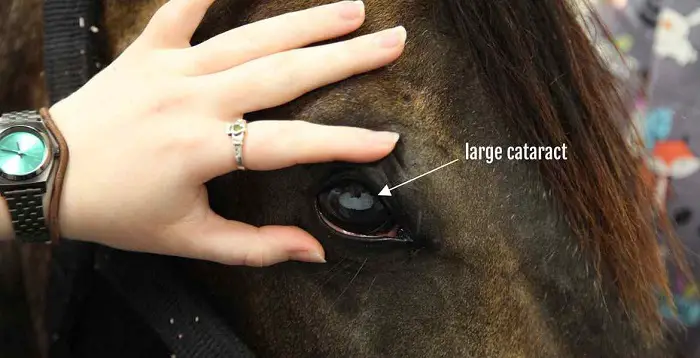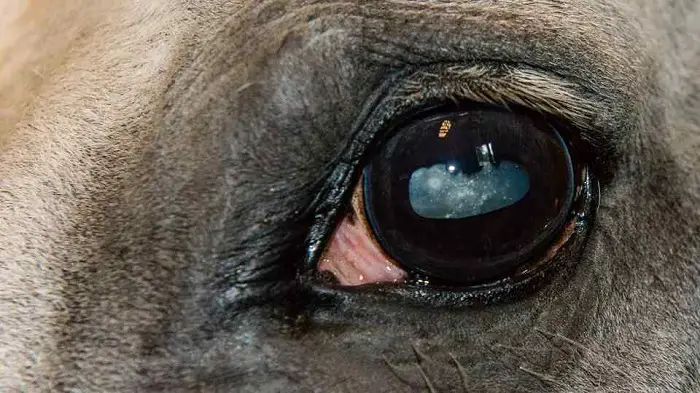Cataracts in horses refer to the development of opacities or cloudiness in the lenses of their eyes. The eye lens is a transparent structure behind the iris that helps focus light onto the retina. When cataracts form, it interferes with the passage of light, leading to visual impairment or blindness.
Cataracts in horses can be congenital (present at birth) or acquired later in life. Congenital cataracts are relatively rare and can be caused by genetic factors or certain prenatal infections. Acquired cataracts, on the other hand, are more common and can develop due to various reasons, including aging, trauma to the eye, inflammation, certain medications, nutritional deficiencies, or systemic diseases such as equine recurrent uveitis.
What is the Most Common Cause of Cataracts in Horses?
The most common cause of cataracts in horses is equine recurrent uveitis (ERU), also known as moon blindness. ERU is an inflammatory disease that affects the eye’s uveal tract, including the iris, ciliary body, and choroid. Over time, chronic inflammation can lead to the formation of cataracts.
ERU is believed to have an autoimmune component, where the horse’s immune system mistakenly targets its ocular tissues. The exact cause of ERU is not fully understood, but it is thought to be triggered by various factors, including infectious agents such as bacteria, viruses, or parasites. Certain breeds, such as Appaloosas and Warmbloods, are more predisposed to developing ERU.
The recurrent nature of the disease means that affected horses experience repeated episodes of uveitis, leading to ongoing inflammation and damage to the eye structures. As a result, cataracts can develop as a long-term consequence of chronic uveitis.
Types of Equine Cataracts
Several types of equine cataracts are classified based on their location within the lens or their specific characteristics. Here are some common types:
- Nuclear Cataracts: These cataracts form in the center (nucleus) of the lens. They are often seen in older horses and can progress over time, causing gradual vision loss.
- Cortical Cataracts: Cortical cataracts develop in the lens’s outer layers (cortex). They appear wedge-shaped or spoke-like opacities and can cause various visual disturbances depending on their size and location.
- Posterior Subcapsular Cataracts: These cataracts occur at the back surface of the lens, just beneath the lens capsule. They may develop rapidly and significantly impact vision, causing glare, halos, and difficulty seeing in bright light.
- Anterior Subcapsular Cataracts: Anterior subcapsular cataracts form on the front surface of the lens, close to the lens capsule. They can cause significant visual impairment and are often associated with other eye conditions, such as equine recurrent uveitis.
- Congenital Cataracts: Congenital cataracts are present at birth or develop shortly after. They can vary in size, shape, and location. Congenital cataracts may be hereditary or result from intrauterine infections or other developmental abnormalities.
- Traumatic Cataracts: Traumatic cataracts result from injury or trauma to the eye, such as a penetrating wound or blunt trauma. They can occur at any location within the lens and may vary in severity and prognosis depending on the extent of the damage.
Clinical Signs of Cataracts in Horses
Cataracts in horses can cause various clinical signs and visual disturbances. The specific signs may vary depending on the cataracts’ severity, location, and progression. Here are some common clinical signs associated with equine cataracts:
- Gradual Loss of Vision: Horses with cataracts often experience a progressive decline in vision. Initially, they may have difficulty seeing objects or obstacles in their environment. As the cataracts worsen, vision loss can become more pronounced.
- Increased Sensitivity to Light: Cataracts, known as photophobia, can cause increased sensitivity to light. Horses may squint, exhibit excessive tearing or aversion to bright sunlight or other intense light sources.
- Changes in Behavior: Horses with cataracts may display changes in behavior. They might become hesitant to move, particularly in unfamiliar or challenging environments. They may also show signs of anxiety or nervousness due to compromised vision.
- Altered Depth Perception: Cataracts can affect a horse’s depth perception. They may misjudge distances or need help accurately gauging the height of obstacles, leading to stumbling or tripping.
- Cloudiness or Opacity in the Eye: Cataracts can manifest as visible cloudiness or opacities in the affected eye. The degree of cloudiness can vary depending on the severity of the cataract and can be observed during a thorough eye examination.
Diagnosis of Equine Cataracts
The diagnosis of equine cataracts is typically made through a comprehensive ophthalmic examination performed by a veterinarian or a veterinary ophthalmologist. The examination may involve the following steps:
- History and Clinical Signs: The veterinarian will begin by discussing the horse’s medical history and any observed clinical signs related to the eyes or vision. This information helps understand cataracts’ onset, progression, and potential underlying causes.
- Visual Assessment: The veterinarian will evaluate the horse’s vision using various methods. These may include observing the horse’s response to visual stimuli, assessing the pupillary reflexes, and conducting tests to determine visual acuity.
- Slit Lamp Biomicroscopy: A slit lamp biomicroscope is a specialized instrument used to examine the eye’s structures in detail. It provides a magnified view of the cornea, lens, and other ocular tissues. The veterinarian will use the slit lamp to assess the cataracts’ presence, location, and characteristics.
- Ocular Examination: The veterinarian will conduct a thorough examination of the horse’s eyes, including an assessment of the overall health of the eye, the presence of inflammation, and any other concurrent eye conditions that may be associated with cataracts.
- Additional Diagnostic Tests: In some cases, the veterinarian may perform additional diagnostic tests to gather more information or rule out other potential causes. These tests may include tonometry to measure intraocular pressure, ocular ultrasonography to evaluate the internal structures of the eye, or blood tests to assess for underlying systemic diseases.
Combining the history, clinical signs, and findings from the ophthalmic examination will help diagnose equine cataracts definitively.
Differential Diagnosis of Cataracts in Horses
When diagnosing cataracts in horses, it is essential to consider other potential causes of cloudy or opaque areas in the lens and other eye conditions that can lead to visual impairment. Here are some differential diagnoses to consider:
- Lens Luxation: Lens luxation refers to the displacement or dislocation of the lens from its normal position. It can cause similar visual disturbances and cloudiness in the eye. Lens luxation can be congenital or acquired due to trauma, inflammation, or genetic factors.
- Corneal Opacities: Opacities or cloudiness in the cornea, the transparent outermost layer of the eye, can mimic cataractous changes. Corneal ulcers, scars, dystrophies, or deposits can cause cloudiness and affect vision.
- Inflammatory Eye Conditions: Various inflammatory eye conditions can cause cloudiness and visual impairment. Equine recurrent uveitis (ERU), for example, can lead to cataracts but may also cause other characteristic signs such as ocular inflammation, tearing, and changes in iris coloration.
- Congenital Abnormalities: Some congenital eye abnormalities may result in cloudiness or opacities in the lens. These can include persistent pupillary membranes, lenticonus, or colobomas.
- Systemic Diseases: Certain systemic diseases can cause ocular manifestations, including cloudiness in the lens. Conditions like equine metabolic syndrome, hyperlipemia, or nutritional deficiencies may lead to cataract formation.
- Trauma or Injury: Trauma to the eye can cause cloudiness or opacities in the lens, mimicking cataracts. Blunt force trauma, penetrating injuries, or foreign body involvement should be considered.
How do You Treat Cataracts in Horses?
The treatment options for cataracts in horses are limited compared to those available for humans and other animals. Currently, surgical removal of cataracts, a standard treatment in humans, is challenging and rarely performed in horses due to several factors, including the size of their eyes, the risks associated with anesthesia, and the potential for postoperative complications. As a result, management strategies for equine cataracts often focus on preventing or managing secondary complications and maintaining the horse’s overall ocular health. Here are some approaches:
- Regular Monitoring: Horses with cataracts should undergo regular monitoring of their ocular health and vision. This involves routine veterinary check-ups, including comprehensive eye examinations, to assess the progression of cataracts and any associated changes or complications.
- Protective Eyewear: Protective eyewear, such as fly masks or specially designed goggles, can help shield the horse’s eyes from environmental irritants, UV radiation, and potential injuries. These can provide some level of protection to minimize further eye damage.
- Management of Secondary Conditions: Horse cataracts are often associated with other ocular conditions or underlying diseases. Managing these secondary conditions minimizes inflammation, prevents infection, and preserves the horse’s visual function. As a veterinarian prescribes, this may involve anti-inflammatory medications, topical treatments, or systemic medications.
- Environmental Adaptations: Making environmental modifications can assist horses with compromised vision due to cataracts. This may involve keeping the horse in a familiar and consistent environment, minimizing obstacles, and ensuring adequate lighting conditions in their living space.
Prevention of Equine Cataracts
While it’s not always possible to prevent equine cataracts, specific measures can help reduce the risk or delay the onset of cataract formation in horses. Here are some preventive strategies to consider:
- Regular Veterinary Care: Providing regular veterinary care for your horse is essential. Schedule routine wellness exams, including thorough eye examinations, to monitor the health of your horse’s eyes and detect any potential issues at an early stage.
- Eye Protection: Protecting your horse’s eyes from trauma and environmental irritants can help reduce the risk of cataracts. Protective eyewear, such as well-fitted fly masks or goggles, shield the eyes from flying debris, UV radiation, and insects.
- Minimize Exposure to Infections: Certain infections, such as those associated with equine recurrent uveitis (ERU), can increase the risk of cataracts. Take measures to minimize your horse’s exposure to infectious agents, practice good biosecurity, and promptly treat ocular infections or inflammations.
- Proper Nutrition: A balanced and nutritious diet is crucial for maintaining overall equine health, including ocular health. Ensure your horse’s diet includes appropriate amounts of essential vitamins, minerals, and antioxidants. Consult with a veterinarian or equine nutritionist to ensure your horse’s nutritional needs are met.
- Environmental Management: Maintaining a clean and hygienic environment for your horse can help prevent eye infections and inflammation. Regularly remove debris, dust, and irritants from the horse’s living space and provide access to fresh water.
- Genetic Selection: If you’re involved in breeding horses, consider genetic selection to reduce the likelihood of passing on hereditary eye conditions. Work with knowledgeable breeders, consult veterinary professionals and consider appropriate genetic testing and screenings to make informed breeding decisions.
Final Advice on Cataracts in Horses
Remember, cataracts in horses can present challenges regarding treatment options compared to other animals. The primary goal is to manage the condition, prevent secondary complications, and ensure the horse’s well-being. Working closely with a veterinarian or veterinary ophthalmologist experienced in equine ophthalmology will provide the best care for your horse’s ocular health.

